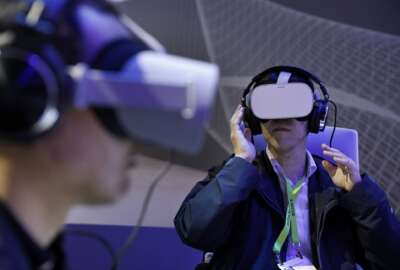
Virtual reality is more than fun and games at the VA
Immersive technology has shown real promise in treating both physical and psychological illnesses. It is taking hold at the Veterans Health Administration, enabled...
Immersive technology has shown real promise in treating both physical and psychological illnesses. It is taking hold at the Veterans Health Administration, enabled by a special network called the Extended Reality Network. The leaders of the team that built the network are finalists in this year’s Service to America Medals Program. Federal Drive with Tom Temin spoke with Anne Lord Bailey and Caitlin Rawlins.
Interview Transcript:
Tom Temin And tell us exactly what happens at the office that you guys had the Clinical Tech Innovation unit. What happens there? What’s the goal here overall?
Anne Lord Bailey We work with the Office of Health Care Innovation and Learning. We’re a program within that office, and that office is really leaning into designing, developing, testing, scaling a variety of innovation across VA, because what we want is for our veterans to have the access to the soonest and best care. And we want our clinicians and our frontline staff to be healthy and whole. So we want to lean into whole health as well. And if there are ways that we can leverage clinical tech and innovation in that space to help support those initiatives, we certainly want to do that.
Tom Temin And Ms. Rawlins, how has, I guess, augmented reality, virtual reality, immersive technology, these are all, I guess, related or maybe the same thing. What do they do for people that they can benefit from?
Caitlin Rawlins So extended reality is definitely the kind of umbrella term, we also use immersive technology as kind of an umbrella term for both virtual reality and augmented reality, but it really depends on how you’re using it with an individual. So a lot of our use in the VA currently centers around virtual reality for patient facing solutions. So it may be general positive distraction to aid with a lot of different diagnoses, or it may be existing evidence based modalities through the new mode of virtual reality. And then of course, there’s also education and training, which may more often use either VR or AR, but that can be for clinical skills or other types of skills and education that need to be provided to both staff, patients and or their caregivers, depending on what the particular platform is.
Tom Temin And the other technology that VA has been really a leader in, not just from the pandemic, but maybe that accelerated it is telemedicine. And can VR and AR, augmented reality, can they also coexist in a Telatype of situation?
Caitlin Rawlins They definitely can. And so that is something that the VA is pursuing right now, is how do we get these devices into the hands of patients in their homes to help extend the reach of the health care system, extend the reach of actual clinicians, and also empower patients to take over some of their own care, take responsibility for their own care, using these devices independently at home. So we actually have one pilot right now where we’re sending devices home with patients for chronic pain management and using a program that’s based off cognitive behavioral therapy that they use independently every day to hopefully aid with their overall pain management and learning how to become more resilient to the symptoms of chronic pain. So that is a current pilot, but that is absolutely something that’s possible.
Tom Temin I guess that beats swinging a imaginary sword at an imaginary foe and crashing into your television set because you can’t see it.
Caitlin Rawlins That is very true. That sounds much more hazardous to the health than what we were going for.
Tom Temin Sure. And Ms. Bailey, this [extended reality (XR)] network, it’s not a network of wires and high bandwidth connections, is it?
Anne Lord Bailey No, this is a network of people, which is something that we’ve seen be incredibly powerful as this collaborative community. So I know we threw a lot of names out and about, but we had a VA immersive team that focuses on continuing to expand use of immersive technology like virtual reality and augmented reality across VA. And one of the programs within the immersive is this XR network. And what we’ve seen is this ground up effort, this groundswell of frontline staff and veterans who every time they put their head in a headset, just one of our mantras get heads and headsets. Every time a veteran or clinician puts their head in a headset, the way that you see the demeanor of that person change and then as soon as they take the headset off is what else can we use this for? When we see those kinds of things, we know this is something that we need to do more of and we need to invest human capital. We need to invest resources in, because the veterans and staff are asking for more. And what’s really fascinating about it, it’s not just one discipline. It’s not just physicians or nurses or social workers. It’s disciplines across the entire health care system.
Tom Temin We’re speaking with Anne Lord Bailey and Caitlin Rawlins, they lead the clinical tech innovation team at the Veterans Health Administration, and they’re finalists in this year’s Service to America Medals Program. And when there’s a new, say, surgical procedure, the people that do surgery have to learn this. And sometimes you have to go for additional training, maybe an institute that pioneered that procedure, or if there’s a new drug there’s all kinds of things you need to learn. This is a new medical delivery system, which you said is diffused among not just physicians, but nurses, nurse practitioners, physicians assistants. I guess anyone that would come in contact with a patient. So in this XR network, what kinds of training and materials do people get such that they can responsibly get into the VR work with patients?
Anne Lord Bailey That’s a great question. So I’m actually a pharmacist by training, Caitlin is a nurse. It’s been one of the really exciting things, as we said, that we’ve seen. And we provide, now, of course, we call it XR 101 and it offers 20 different continuing education units across multiple disciplines, physical therapists, occupational therapists, recreation therapists. That’s one of the values of being in VA, is that VA really allows clinicians and providers to function at the top of their license, and we’re able to now train those clinicians now to use this new modality. It’s been really exciting to see.
Tom Temin And when it comes to just a specific question, pain management is an important endeavor for VA. Always has been. And VA was a pioneer in the responsible use of the OxyContin and so forth and how to get off it quickly in this kind of thing. What happens in the headset, for example, that can help people with pain management?
Caitlin Rawlins So that can be, like I said, a lot of different things. So it might be something like cognitive behavioral therapy, where they’re doing mindfulness and deep breathing and other already evidence based modalities in virtual reality. And the benefit of virtual reality is that it’s more immersive. You actually feel more engaged with the content, because you are present in this virtual world. And that’s the same thing with any type of education and training. And as we know, cognitive behavioral therapy it’s really about training your brain. So similar to how we would do any sort of clinical training or other types of education and training in VR, same thing with the patients. So it’s educating them in a more engaging, immersive way that allows for better knowledge retention when it comes to how they’re training themselves to better manage their own chronic pain. And then, of course, for pain management, it can also be as simple as positive distraction where they’re playing interactive games or they’re traveling to places all over the world. Because especially if you’re in acute pain post operatively, what you need is a distraction. You need something to interrupt that pain signal going to your brain by introducing positive stimuli. And so that’s what virtual reality is able to do in that capacity as well.
Tom Temin Because the question comes up for people that might have chronic pain, it’s great if you’re in that headset when you take a pill, it’ll last for 4 hours or 6 hours. You take off the headset and you might feel great. But then you get in the car to drive over to the VFW hall and all the traffic and the tension returns. Does this have a lasting effect outside of the headset, I guess is my question.
Caitlin Rawlins So that’s something that’s definitely still under investigation. And one of the things that we hope to help answer is exactly how long does the effect last? We know that it works incredibly well in that moment and immediately following a session. But what is the cadence for use, and how long do they need to use it each time they use it to create a lasting effect? Or if you’re using it for something like cognitive behavioral therapy, how does that help them to learn how to handle those situations when their pain gets triggered again? So, yes, they’re fine when they were leaving their house, but then traffic, everything else, everything compounded on itself, now they’re feeling it again. How do we use virtual reality to train them, even in those moments, to kind of bring themselves back down out of that pain or out of the anxiety or whatever it might be, whatever diagnosis they might be dealing with.
Anne Lord Bailey Anecdotally, we hear those reports from veterans and even some of our clinicians and staff that have tried virtual reality. They may, obviously, be walking around a grocery store without a headset on. Something is triggering to them, whether it be pain or anxiety related. And they recall some of those experiences they had while they were in the headset. That psychological presence really is transformative. So as Caitlin said, that’s something we certainly want to continue to contribute to that rigorous evidence for.
Tom Temin And as a program, let’s get back to the program aspects of this, because VA has however many hundred and odd big medical centers, hundreds of more places of delivery throughout the country, private places of delivery. How are you ensuring that this becomes equally accessible by all veterans across a really large system where it might take five years to deploy a new pill bottle?
Anne Lord Bailey That’s what’s been so exciting about the network. VA has 171 health care systems, over 1200 sites of care, 9 million veterans and almost 400,000 staff. So how do we reach all those people with a team of four? And Caitlin and I, we’re doing this as a team of two until the last six months, but that’s where we really lean into and leverage that network and try to empower the field so that we can multiply ourselves. If we can build expertise in the field, then what we really need to do is open up opportunities and then equip people and they’re able to multiply it. So we can say right now our team has supported dissemination of over 1200 headsets across 30 different clinical uses, and at least 120 unique medical centers have received support directly from us. And there’s almost 170 medical centers that are engaged with the network. So they’re learning from us, but we haven’t necessarily specifically trained them or sitting in headsets, but they’re engaged in using some of the resources that we provide.
Tom Temin And I guess some of the younger veterans that might already have headsets could bring it in and plug in and get the treatment that way.
Caitlin Rawlins That’s very true. And we do have multiple accounts of that actually occurring where even some of the patients that were introduced to it in VA care, before we were even able to get a device in their hands, they found it so valuable they went out and bought a VR headset themselves that they then use for chronic pain, for their anxiety, for encounters that may trigger their PTSD for social isolation, even. So, we do have patients that seek it out all by themselves. And I wanted to make a point to you about the resources. So one of the things that the XR network does is helps to build kind of nationally available resources for clinical staff to make it easier for them to integrate this technology into the standard of care, the standard of practice, because that’s one thing that we know for sure. When you have new technology and you’re trying to integrate it into health care, unless they have adequate support to help them to do that, it’ll end up sitting on a shelf, because clinicians are busy, they get overwhelmed, they don’t have the time to figure out how to do it, how to fit it into their existing clinical workflow. So that’s something that we really tried to help do and I think has been very successful in making it easier for all of those 170 plus sites to actually integrate the technology into care at individual VA.
Copyright © 2024 Federal News Network. All rights reserved. This website is not intended for users located within the European Economic Area.
Tom Temin is host of the Federal Drive and has been providing insight on federal technology and management issues for more than 30 years.
Follow @tteminWFED





